N-S-co-Doped Carbon Dot Blue Fluorescence Preparation and Baicalein Detection
Abstract
1. Introduction
2. Results and Discussion
2.1. Morphology and Structure of cys-CD
2.2. Optical Properties of cys-CD
2.3. Stability of cys-CD Fluorescence
2.4. Baicalein Detection
2.5. Mechanism Verification of Baicalein Detection Using cys-CDs
2.6. Fluorescence Inner-Filter Effect
2.7. Static Quenching Effect
2.8. Baicalein Detection in Biological Samples
3. Materials and Methods
3.1. Baicalein Detection Methods
3.1.1. UV-Vis Spectrophotometry
3.1.2. Mass Spectrometry
3.1.3. High-Performance Liquid Chromatography
3.2. Reagents and Equipment
3.3. Synthesis and Purification of Blue-Fluorescent S, N-co-Doped CDs (cys-CD)
3.4. Fluorescence Properties of cys-CD
3.5. cys-CD Fluorescence Quantum Yield
3.6. Fluorescence Lifetime
3.7. Optimization of Baicalein Measurement Conditions
3.7.1. Effect of cys-CD Concentration
3.7.2. In Vitro pH Effects
3.7.3. Effect of Reaction Time
3.7.4. Effect of Ionic Strength
3.7.5. Baicalein Detection
3.8. Mechanism of Baicalein Detection
3.8.1. Effect of Baicalein on cys-CD UV-Vis Absorbance Spectrum
3.8.2. Effect of Baicalein on cys-CD Fluorescence Lifetime
3.8.3. Detection of Baicalein in Urine and Blood Using cys-CD
4. Conclusions
Author Contributions
Funding
Data Availability Statement
Conflicts of Interest
References
- Zhang, Y.; Yao, H.; Xu, Y.; Xia, Z. Synergistic Weak/Strong Coupling Luminescence in Eu-Metal-Organic Framework/Zn2GeO4:Mn2+ Nanocomposites for Ratiometric Luminescence Thermometer. Dyes Pigments 2018, 157, 321–327. [Google Scholar] [CrossRef]
- Zhou, Y.; Zhang, D.; Zeng, J.; Gan, N.; Cuan, J. A Luminescent Lanthanide-Free MOF Nanohybrid for Highly Sensitive Ratiometric Temperature Sensing in Physiological Range. Talanta 2018, 181, 410–415. [Google Scholar] [CrossRef] [PubMed]
- Gharari, Z.; Bagheri, K.; Danafar, H.; Sharafi, A. Simultaneous Determination of Baicalein, Chrysin and Wogonin in Four Iranian Scutellaria species by High Performance Liquid Chromatography. J. Appl. Res. Med. Aromat. Plants 2020, 16, 100232. [Google Scholar] [CrossRef]
- Zhang, X.; Zhu, Z.; Guo, Z.; Sun, Z.; Chen, Y. A Ratiometric Optical Thermometer with High Sensitivity and Superior Signal Discriminability Based on Na3Sc2P3O12: Eu2+, Mn2+ Thermochromic Phosphor. Chem. Eng. J. 2019, 356, 413–422. [Google Scholar] [CrossRef]
- Zhang, X.; Zhu, Z.; Guo, Z.; Sun, Z.; Yang, Z.; Zhang, T.; Zhang, J.; Wu, Z.C.; Wang, Z. Dopant Preferential Site Occupation and High Efficiency White Emission in K2BaCa(PO4)2:Eu2+,Mn2+ Phosphors for High Quality White LED Applications. Inorg. Chem. Front. 2019, 6, 1289–1298. [Google Scholar] [CrossRef]
- Bai, Y.M.; Mao, J.; Li, D.X.; Luo, X.J.; Chen, J.; Tay, F.R.; Niu, L.N. Bimodal Antibacterial System Based on Quaternary Ammonium Silane-Coupled Core-Shell Hollow Mesoporous Silica. Acta Biomater. 2019, 85, 229–240. [Google Scholar] [CrossRef] [PubMed]
- An, G.S.; Shin, J.R.; Hur, J.U.; Oh, A.H.; Kim, B.; Jung, Y.; Choi, S. Fabrication of Core-Shell Structured Fe3O4@Au Nanoparticle via Self-Assembly Method Based on Positively Charged Surface Silylation/Polymerization. J. Alloys Compd. 2019, 798, 360–366. [Google Scholar] [CrossRef]
- Bardi, B.; Tosi, I.; Faroldi, F.; Baldini, L.; Sansone, F.; Sissa, C.; Terenziani, F. A Calixarene-Based Fluorescent Ratiometric Temperature Probe. Chem. Commun. 2019, 55, 8098–8101. [Google Scholar] [CrossRef] [PubMed]
- Wu, Z.; Tan, B.; Velasco, E.; Wang, H.; Shen, N.N.; Guo, Y.J.; Zhang, X.; Zhu, K.; Zhang, G.Y.; Liu, Y.Y.; et al. Fluorescent in Based MOFs Showing “Turn On” Luminescence towards Thiols and Acting as a Ratiometric Fluorescence Thermometer. J. Mater. Chem. C 2019, 7, 3049–3055. [Google Scholar] [CrossRef]
- Macairan, J.R.; Jaunky, D.B.; Piekny, A.; Naccache, R. Intracellular Ratiometric Temperature Sensing Using Fluorescent Carbon Dots. Nanoscale Adv. 2019, 1, 105–113. [Google Scholar] [CrossRef]
- Liu, X.; Liu, J.; Zhou, H.; Yan, M.; Liu, C.; Guo, X.; Xie, J.; Li, S.; Yang, G. Ratiometric Dual Fluorescence Tridurylboron Thermometers with Tunable Measurement Ranges and Colors. Talanta 2020, 210, 120630. [Google Scholar] [CrossRef]
- Yin, P.; Niu, Q.; Yang, Q.; Lan, L.; Li, T. A New “Naked-Eye” Colorimetric and Ratiometric Fluorescent Sensor for Imaging Hg2+ in Living Cells. Tetrahedron 2019, 75, 130687. [Google Scholar] [CrossRef]
- Wu, X.Y.; Zhao, Q.; Zhang, D.X.; Liang, Y.C.; Zhang, K.K.; Liu, Q.; Dong, L.; Shan, C.X. A Self-Calibrated Luminescent Thermometer Based on Nanodiamond-Eu/Tb Hybrid Materials. Dalton Trans. 2019, 48, 7910–7917. [Google Scholar] [CrossRef] [PubMed]
- Gao, H.; Kam, C.; Chou, T.Y.; Wu, M.Y.; Zhao, X.; Chen, S. A Simple yet Effective AIE-Based Fluorescent Nano-thermometer for Temperature Mapping in Living Cells Using Fluorescence Lifetime Imaging Microscopy. Nanoscale Horiz. 2020, 5, 488–494. [Google Scholar] [CrossRef]
- He, S.; Qi, S.; Sun, Z.; Zhu, G.; Zhang, K.; Chen, W. Si, N-codoped Carbon Dots: Preparation and Application in Iron Overload Diagnosis. J. Mater. Sci. 2019, 54, 4297–4305. [Google Scholar] [CrossRef]
- Xia, W.; Zhang, W. Characterization of surface properties of Inner Mongolia coal using FTIR and XPS. Energy sources part a-recovery utilization and environmental effects. Energy Sources Part A Recover. Util. Environ. Eff. 2017, 39, 1190–1194. [Google Scholar]
- Zhu, S.J.; Meng, Q.N.; Wang, L.; Zhang, J.; Song, Y.; Jin, H.; Zhang, K.; Sun, H.; Wang, H.; Yang, B. Highly photoluminescent carbon dots for multicolor pattrening, sensors, and bioimaging. Angew. Commun. 2013, 52, 3953–3957. [Google Scholar] [CrossRef] [PubMed]
- Ye, Y.; Yang, D.; Chen, H.; Guo, S.; Yang, Q.; Chen, L.; Zhao, H.; Wang, L. A high-efficiency corrosion inhibitor of N-doped citric acid-based carbon dots for mild steel in hydrochloric acid environment. J. Hazard. Mater. 2019, 2020, 121019. [Google Scholar] [CrossRef]
- Wang, C.; Wang, Y.; Shi, H.; Yan, Y.; Liu, E.; Hu, X.; Fan, J. A strong blue fluorescent nanoprobe for highly sensitive and selective detection of mercury(II) based on sulfur doped carbon quantum dots. Mater. Chem. Phys. 2019, 232, 145–151. [Google Scholar] [CrossRef]
- Guo, D.; Dong, Z.; Luo, C.; Zan, W.; Yan, S.; Yao, X. A rhodamine B-based “turn-on” fluorescent sensor for detecting Cu2+ and sulfur anions in aqueous media. RSC Adv. 2014, 4, 5718–5725. [Google Scholar] [CrossRef]
- Vercelli, B.; Donnini, R.; Ghezzi, F.; Sansonetti, A.; Giovanella, U.; La Ferla, B. Nitrogn-doped carbon quantum dots obtained hydrothermally from citric acid and urea: The role of the specific nitrogen centers in their electrochemical and optical responses. Electrochim. Acta 2021, 387, 138557. [Google Scholar] [CrossRef]
- Inada, N.; Fukuda, N.; Hayashi, T.; Uchiyama, S. Temperature Imaging Using a Cationic Linear Fluorescent Polymeric Thermometer and Fluorescence Lifetime Imaging Microscopy. Nat. Protoc. 2019, 14, 1293–1321. [Google Scholar] [CrossRef]
- Nguyen, V.; Si, J.H.; Yan, L.H.; Hou, X. Electron-hole recombination dynamics in carbon nanodots. Carbon 2015, 95, 659–663. [Google Scholar] [CrossRef]
- Wang, W.; Peng, J.; Li, F.; Su, B.; Chen, X.; Chen, X. Phosphorus and Chlorine Co-Doped Carbon Dots with Strong Photoluminescence as a Fluorescent Probe for Ferric Ions. Mikrochim. Acta 2018, 186, 32. [Google Scholar] [CrossRef] [PubMed]
- Wang, S.; Cao, J.; Lu, C. A Naphthalimide-Based Thermometer: Heat-Induced Fluorescence “Turn-On” Sensing in a Wide Temperature Range in Ambient Atmosphere. New J. Chem. 2020, 44, 4547–4553. [Google Scholar] [CrossRef]
- Yang, F.; He, X.; Wang, C.; Cao, Y.; Li, Y.; Yan, L.; Liu, M.; Lv, M.; Yang, Y.; Zhao, X.; et al. Controllable and Eco-Friendly Synthesis of P-Riched Carbon Quantum Dots and Its Application for Copper (II) Ion Sensing. Appl. Surf. Sci. 2018, 448, 589–598. [Google Scholar] [CrossRef]
- Yang, W.; Zhang, H.; Lai, J.; Peng, X.; Hu, Y.; Gu, W.; Ye, L. Carbon Dots with Red-shifted Photoluminescence by Fluorine Doping for Optical Bio-Imaging. Carbon 2018, 128, 78–85. [Google Scholar] [CrossRef]
- He, X.; Luo, Q.; Zhang, J.; Chen, P.; Wang, H.J.; Luo, K.; Yu, X.Q. Gadolinium-Doped Carbon Dots as Nano-Theranostic Agents for MR/FL Diagnosis and Gene Delivery. Nanoscale 2019, 11, 12973–12982. [Google Scholar] [CrossRef] [PubMed]
- Das, P.; Maity, P.P.; Ganguly, S.; Ghosh, S.; Baral, J.; Bose, M.; Choudhary, S.; Gangopadhyay, S.; Dhara, S.; Das, A.K.; et al. Biocompatible Carbon Dots Derived from Kappa-Carrageenan and Phenyl Boronic Acid for Dual Modality Sensing Platform of Sugar and Its Anti-diabetic Drug Release Behavior. Int. J. Biol. Macromol. 2019, 132, 316–329. [Google Scholar] [CrossRef]
- Zhao, J.; Zheng, Y.; Pang, Y.; Chen, J.; Zhang, Z.; Xi, F.; Chen, P. Graphene Quantum Dots as Full-Color and Stimulus Responsive Fluorescence Ink for Information Encryption. J. Colloid Interface Sci. 2020, 579, 307–314. [Google Scholar] [CrossRef]
- Wang, H.; Wei, J.; Zhang, C.; Zhang, Y.; Zhang, Y.; Li, L.; Yu, C.; Zhang, P.; Chen, J. Red Carbon Dots as Label-Free Two-Photon Fluorescent Nanoprobes for Imaging of Formaldehyde in Living Cells and Zebrafishes. Chin. Chem. Lett. 2020, 31, 759–763. [Google Scholar] [CrossRef]
- Yan, F.; Bai, Z.; Zu, F.; Zhang, Y.; Sun, X.; Ma, T.; Chen, L. Yellow-Emissive Carbon Dots with a Large Stokes Shift Are Viable Fluorescent Probes for Detection and Cellular Imaging of Silver Ions and Glutathione. Mikrochim. Acta 2019, 186, 113. [Google Scholar] [CrossRef] [PubMed]
- Meng, Y.; Yang, M.; Liu, X.; Yu, W.; Yang, B. Zn2+-Doped Carbon Dots, a Good Biocompatibility Nanomaterial Applied for Bio-imaging and Inducing Osteoblastic Differentiation In Vitro. ACS Nano 2019, 14, 1950029. [Google Scholar] [CrossRef]
- Alimunnisa, J.; Ravichandran, K.; Meena, K. Synthesis and characterization of Ag@SiO2 core-shell nanoparticles for antibacterial and environmental applications. J. Mol. Liquids 2017, 231, 281–287. [Google Scholar] [CrossRef]
- Wei, S.Q.; Yin, X.H.; Li, H.Y.; Du, X.Y.; Zhang, L.M. Multi-Color Fluorescent Carbon Dots: Graphitized Sp2 Conjugated Domains and Surface State Energy Level Co-Modulate Band Gap Rather Than Size Effects. Chem. Eur. J. 2020, 26, 8129–8136. [Google Scholar] [CrossRef]
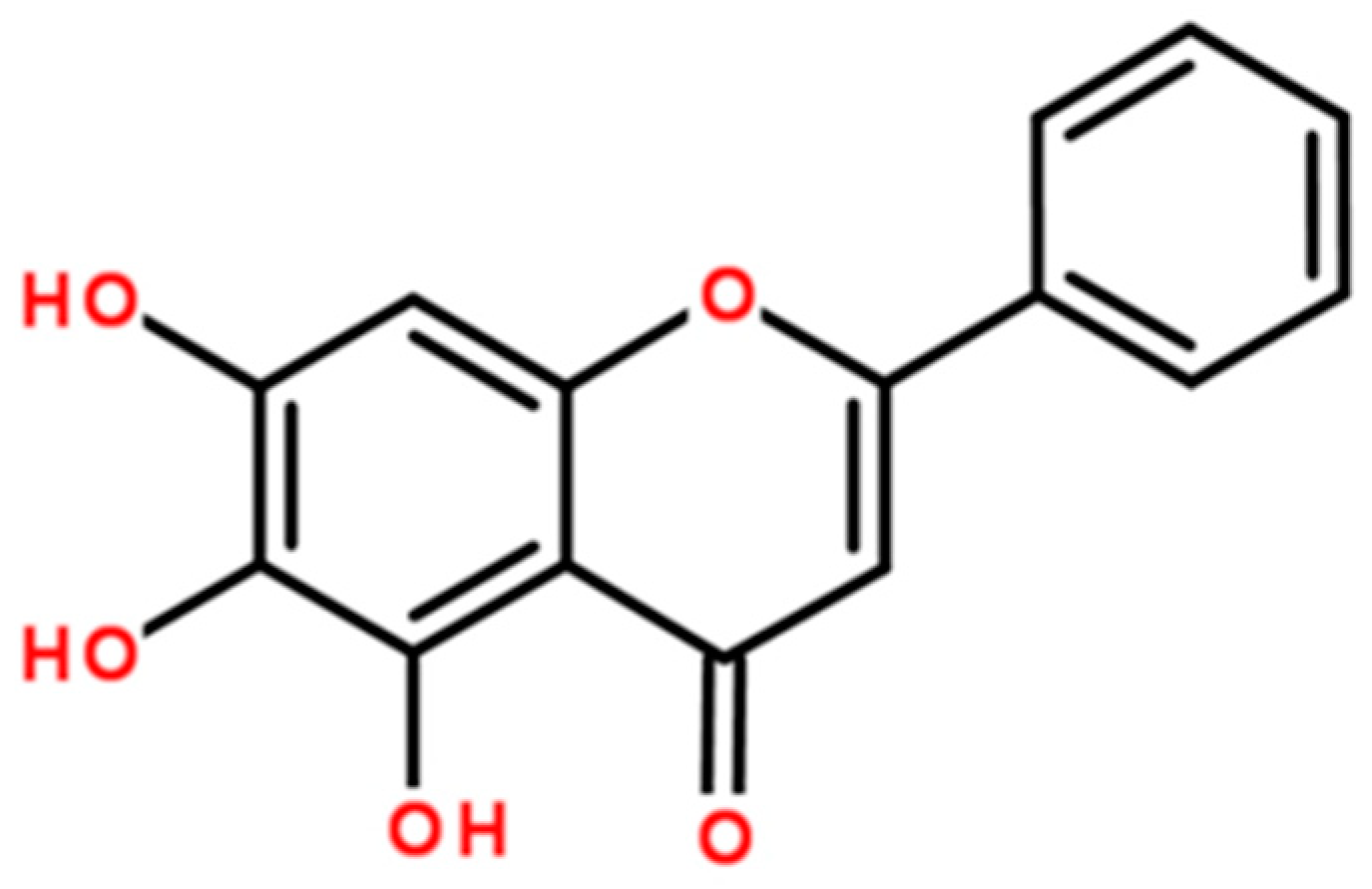


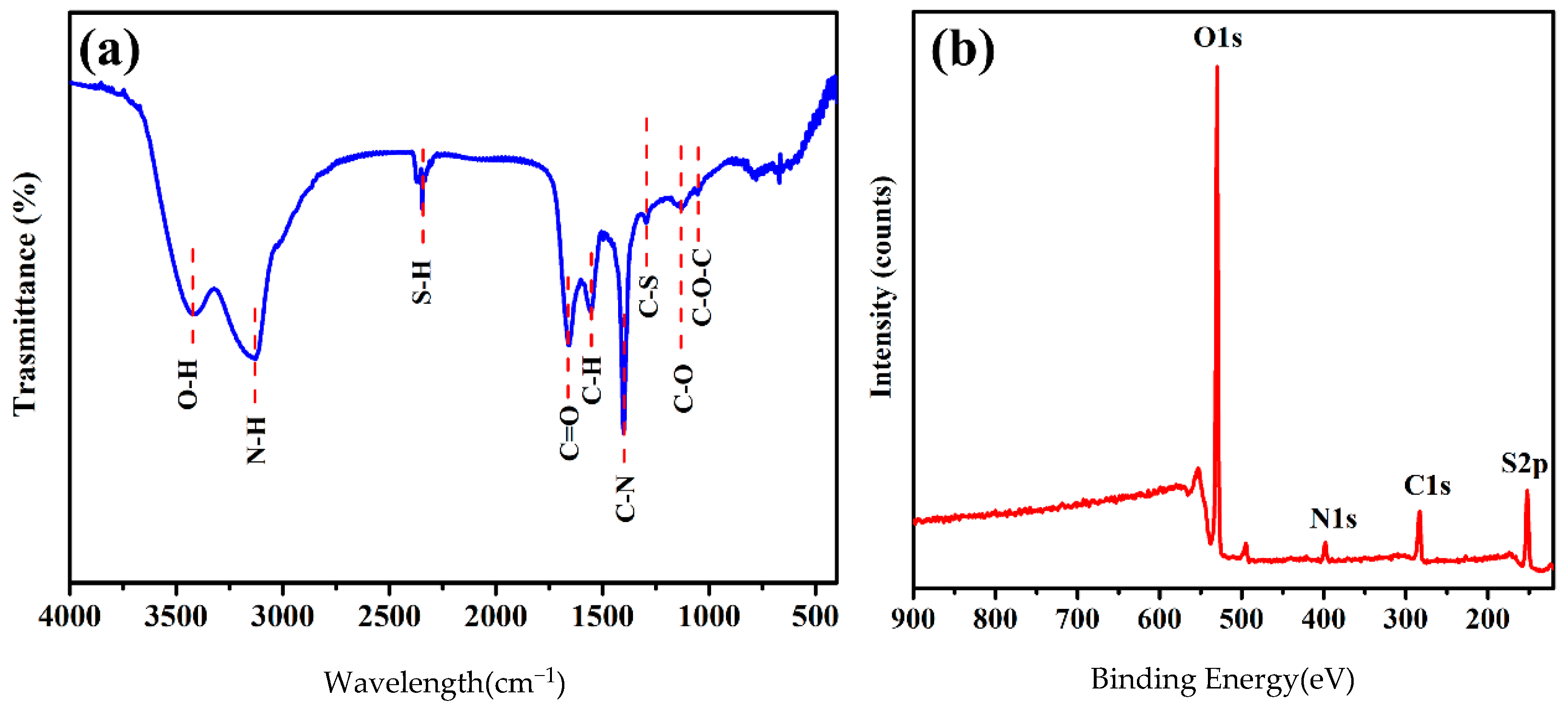
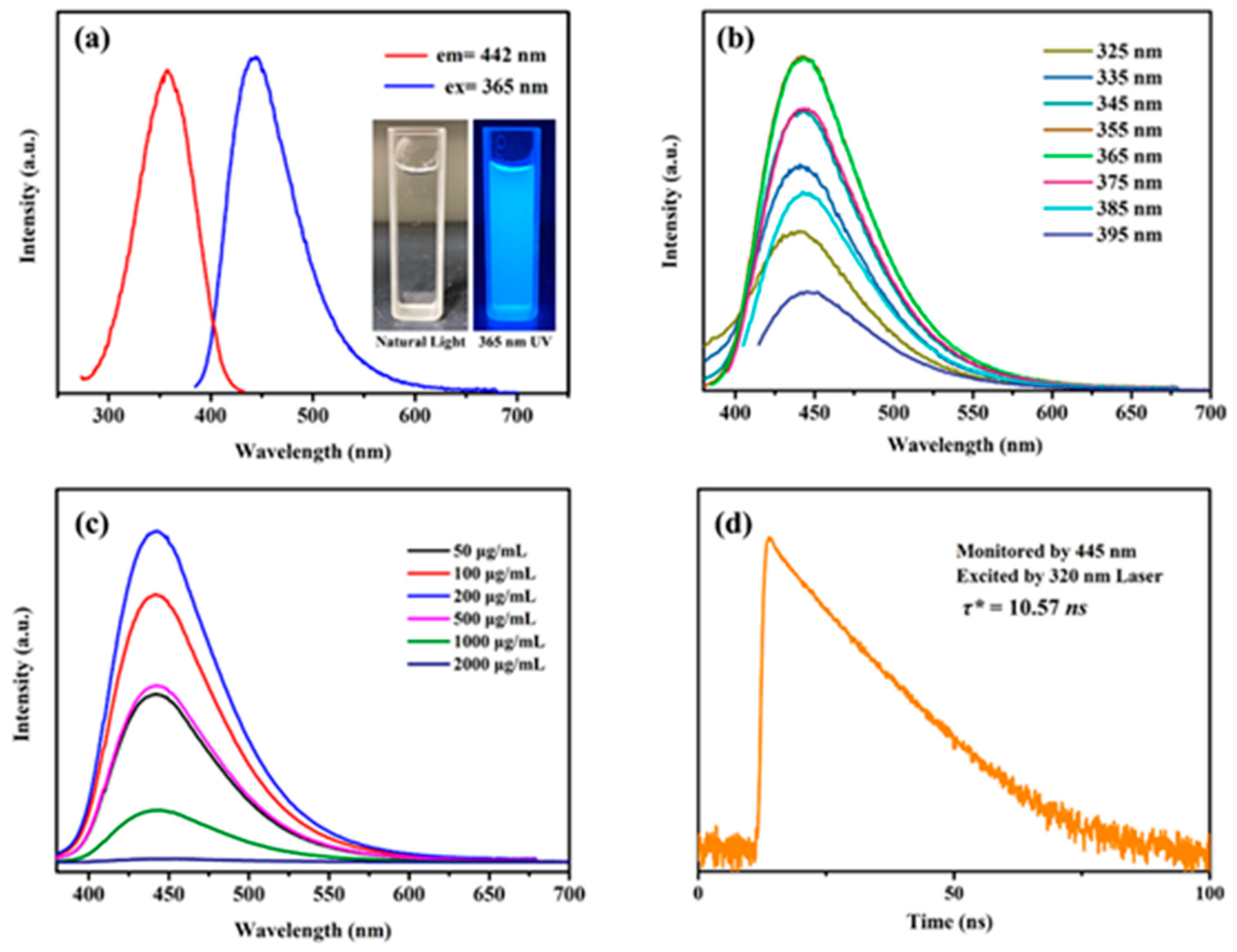
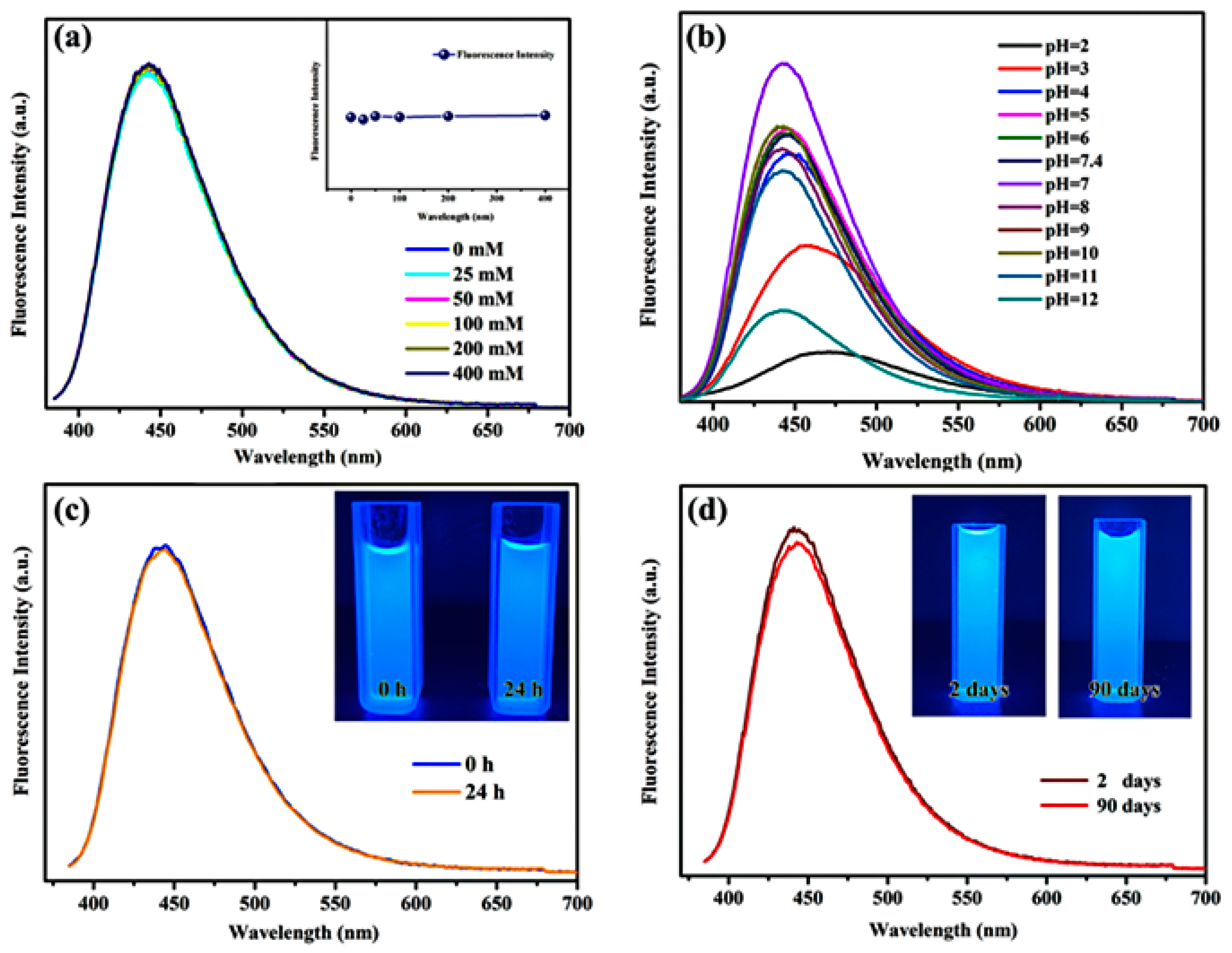
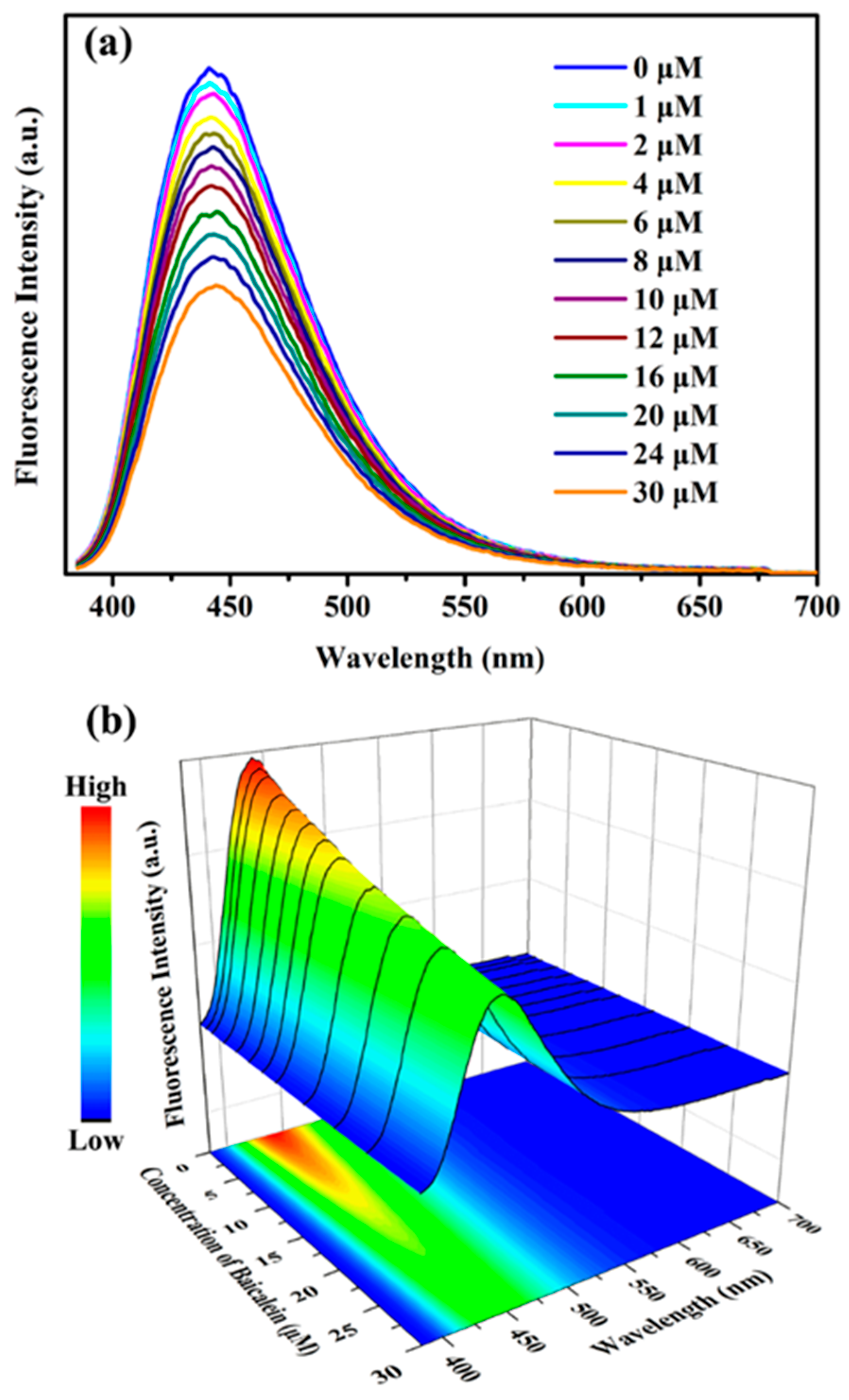
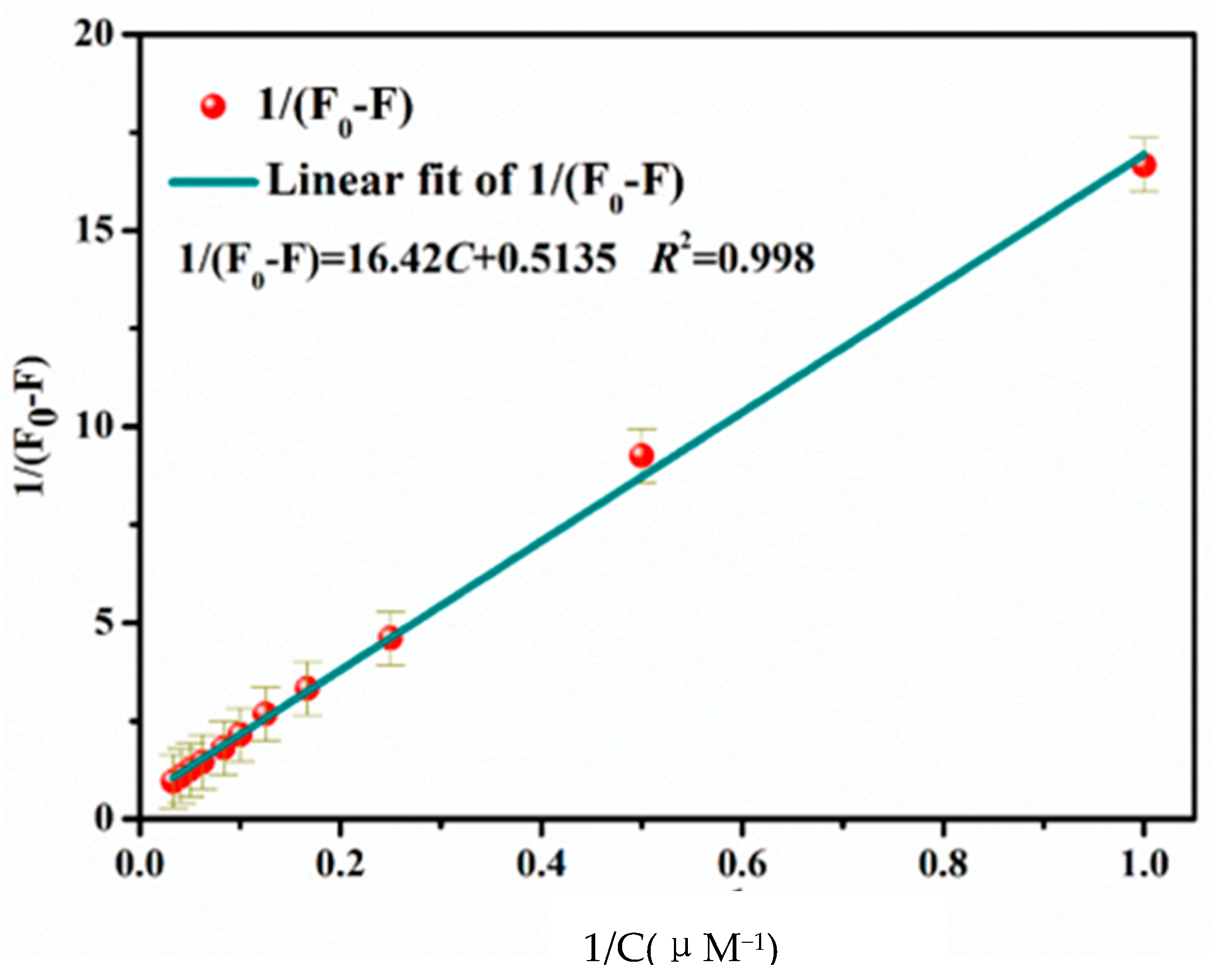

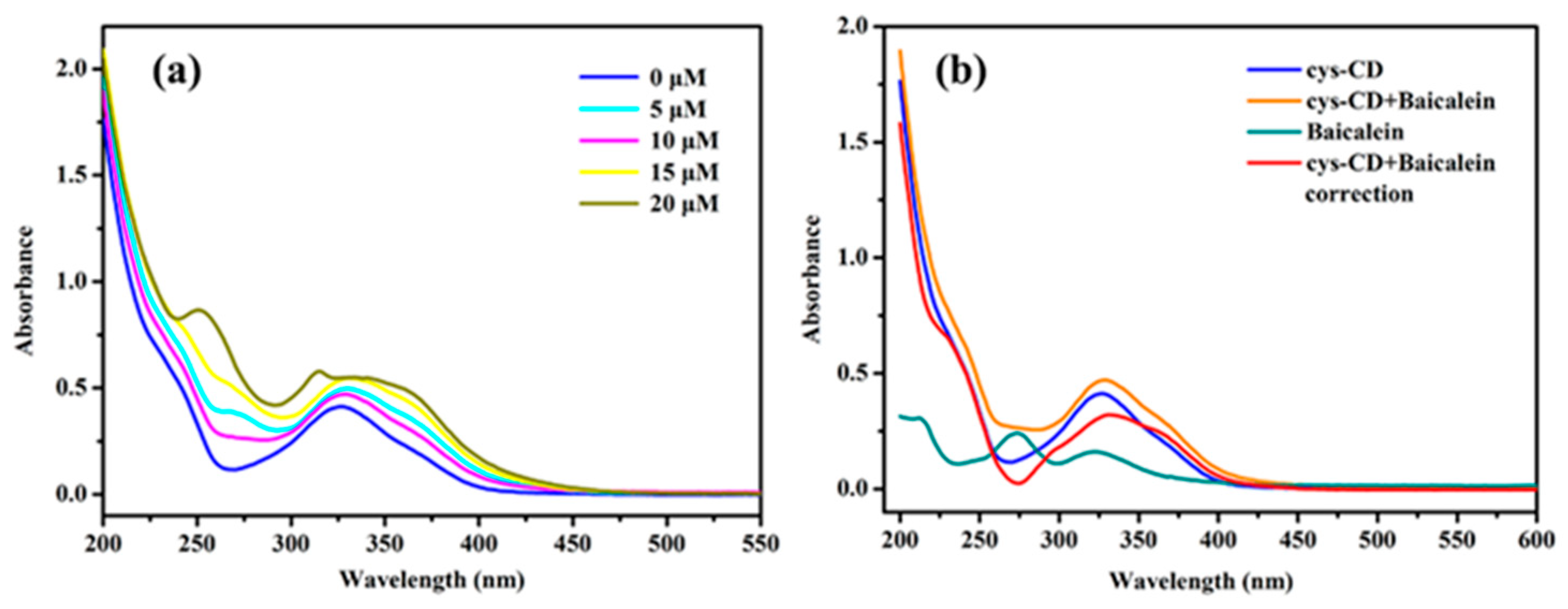
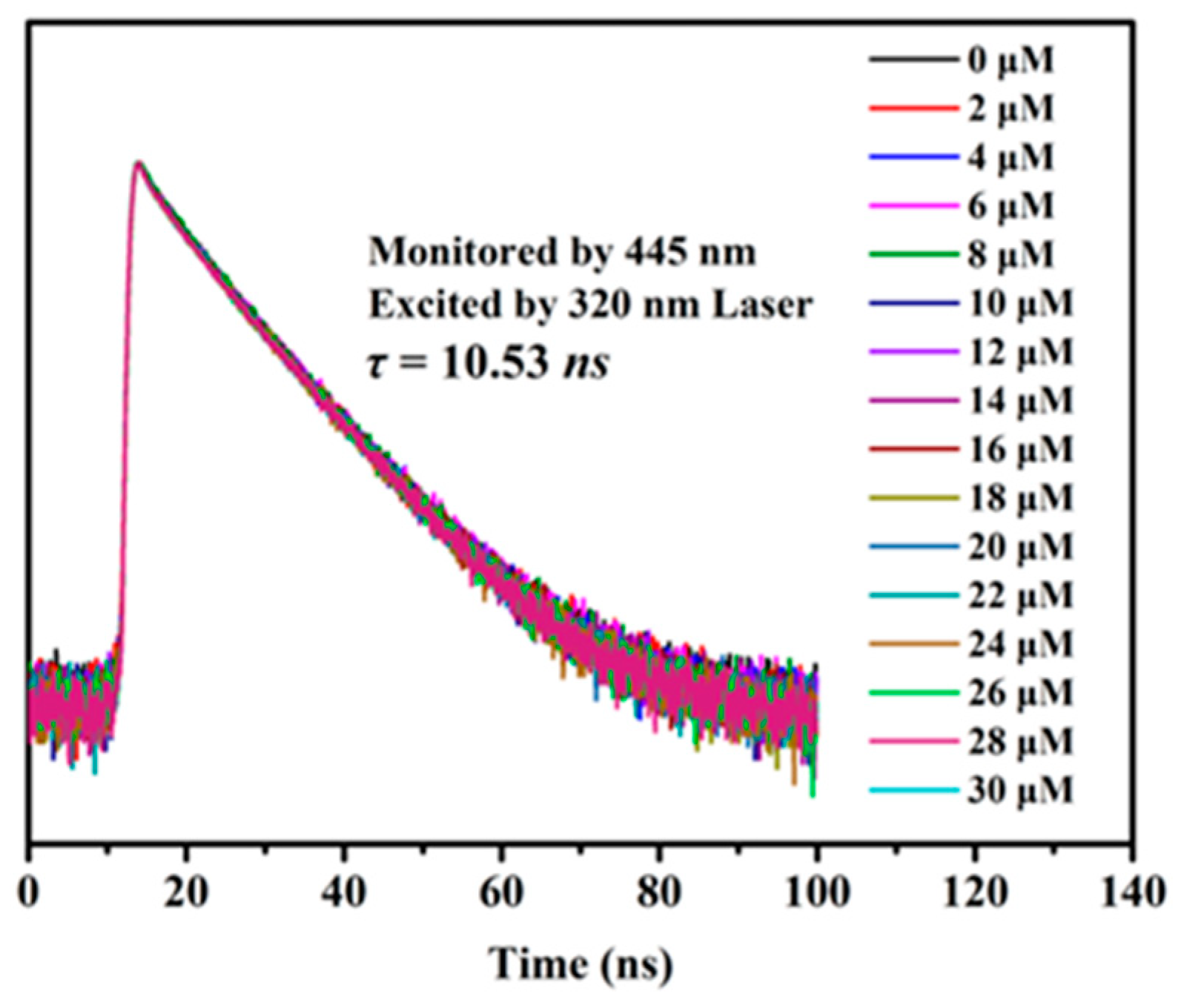
| Sample | Group | Concentration of Baicalein (mM) | Recovery | RSD (%) | |
|---|---|---|---|---|---|
| Spiked | Found | (%) | n = 5 | ||
| Serum | 1 | 8 | 7.85 | 98.19 | 3.81 |
| 2 | 10 | 9.71 | 97.10 | 4.09 | |
| 3 | 12 | 11.74 | 97.87 | 2.44 | |
| Urine | 1 | 8 | 8.28 | 103.49 | 3.52 |
| 2 | 10 | 10.25 | 102.5 | 1.91 | |
| 3 | 12 | 12.23 | 101.93 | 2.77 | |
| Reagents | Purity | Manufacturer |
|---|---|---|
| L-cysteine | Analytical pure | Aladdin Reagent Co., Ltd. (Shanghai, China) |
| Sodium citrate dihydrate | Analytical pure | GHTECH Technology Co., Ltd. (Guangzhou, China) |
| Baicalein standard | 99.8% | Aladdin Reagent Co., Ltd. (Shanghai, China) |
| Sodium chloride | Analytical pure | Damao Chemical Reagent Factory (Tianjin, China) |
| Acetone | Analytical pure | Damao Chemical Reagent Factory (Tianjin, China) |
| EDTA | Analytical pure | Damao Chemical Reagent Factory (Tianjin, China) |
| Absolute alcohol | Analytical pure | GHTECH Technology Co., Ltd. (Guangzhou, China) |
| CTAB | Analytical pure | Aladdin Reagent Co., Ltd. (Shanghai, China) |
| Phosphate buffer (pH 7.4) | Analytical pure | Yuanye Bio-Technology Co., Ltd. (Shanghai, China) |
| DEME culture medium | Analytical pure | Tianjun Bio-Technology Co., Ltd. (Guangzhou, China) |
| 4% PFA stationary liquid | Analytical pure | Bairui Bio-Technology Co., Ltd. (Shanghai, China) |
| Anti-fluorescence quenching mounting medium | Analytical pure | Cida Bio-Technology Co., Ltd. (Guangzhou, China) |
| Instruments | Model | Manufacturer |
|---|---|---|
| Steady/Transient spectrometer | FLS980 | Edinburgh Instrument Company (Edinburgh, Britain) |
| FTIR | 6700 FT-IR | Thermo Fisher Scientific Technology Company (Waltham, MA, USA) |
| UV-Visible-near infrared light spectrophotometer | UV-3600 | Shimadzu Corporation (Kyoto, Japan) |
| TEM | FEI TECNAI G2 F20 | FEI Company (Waltham, MA, USA) |
| Multifunctional XPS | AXIS ULTRA DLD | Shimadzu Corporation (Kyoto, Japan) |
| Liquid nitrogen cryostat | OptistatDN-V2 | Oxford Instruments Technology Co., Ltd. (Shanghai, China) |
| Thermostatic magnetic stirrer | 85-2 | Aohua Instruments Co., Ltd. (Changzhou, China) |
| High-speed centrifuge | TG16-WS | Xiangyi Laboratory Instrument Development Co., Ltd. (Changsha, China) |
| Thermal-Storage heating magnetic stirrer | DF-101S | Yuhua Instruments Co., Ltd. (Gongyi, China) |
| Analytical balance | AX124 ZH/E | Ohaus Corporation (Newark, NJ, USA) |
| UV analyzer | ZF-20D | Yuhua Instruments Co., Ltd. (Gongyi, China) |
| Electric blast drying oven | DHG-9145A | Aohua Instruments Co., Ltd. (Changzhou, China) |
| Laser confocal microscope | LSM 880 with Airyscan | Xiangyi Laboratory Instrument Development Co., Ltd. (Changsha, China) |
| Freeze dryer | Freezone6L | Shimadzu Corporation (Kyoto, Japan) |
Disclaimer/Publisher’s Note: The statements, opinions and data contained in all publications are solely those of the individual author(s) and contributor(s) and not of MDPI and/or the editor(s). MDPI and/or the editor(s) disclaim responsibility for any injury to people or property resulting from any ideas, methods, instructions or products referred to in the content. |
© 2024 by the authors. Licensee MDPI, Basel, Switzerland. This article is an open access article distributed under the terms and conditions of the Creative Commons Attribution (CC BY) license (https://creativecommons.org/licenses/by/4.0/).
Share and Cite
Cheng, Y.; Huang, Y.; Yu, G. N-S-co-Doped Carbon Dot Blue Fluorescence Preparation and Baicalein Detection. Inorganics 2024, 12, 154. https://doi.org/10.3390/inorganics12060154
Cheng Y, Huang Y, Yu G. N-S-co-Doped Carbon Dot Blue Fluorescence Preparation and Baicalein Detection. Inorganics. 2024; 12(6):154. https://doi.org/10.3390/inorganics12060154
Chicago/Turabian StyleCheng, Yujia, Yan Huang, and Guang Yu. 2024. "N-S-co-Doped Carbon Dot Blue Fluorescence Preparation and Baicalein Detection" Inorganics 12, no. 6: 154. https://doi.org/10.3390/inorganics12060154
APA StyleCheng, Y., Huang, Y., & Yu, G. (2024). N-S-co-Doped Carbon Dot Blue Fluorescence Preparation and Baicalein Detection. Inorganics, 12(6), 154. https://doi.org/10.3390/inorganics12060154






